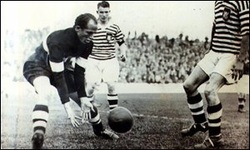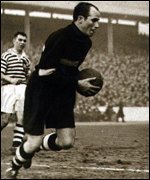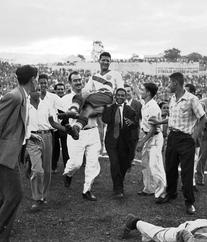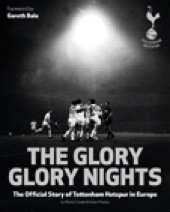 On this trip instead of one tournament we will be looking at two different players who never met and how the World Cup affected their lives. Both were celebrated in their home countries at the time. One of them went on to have a successful career. The other is a much sadder tale. The first Mustafa Kamel Mansour (top image) was the Egyptian goalkeeper in the 1934 World Cup. He was the last surviving member of the team when he gave an interview in 2002. He recalled how he never thought about becoming a footballer. “I was forced to play football at school, there were two teams starting a game in the schoolyard and they were short of a goalkeeper. Our teacher called me to play in goal and I believe I did well, as he made me the school goalkeeper.” He later joined the Al-Ahly club and was chosen for the World Cup. “When we went to the 1934 World Cup, it was only the second one that had been played. we went to Italy on a ship called the Helwan. It was a trip that took four days but we enjoyed the experience.” That tournament was a straight knockout competition (1). Egypt played Hungary in the Southern Italian city of Naples. It was their only game as they lost 2-4. Mansour insisted they gave their opponents a tough contest. "We were the better side, we deserved to win. Mansour insisted that his team were the victims of poor refereeing claiming the Italian referee Rinaldo Barlassina denied them victory against the Eastern Europeans. "When the game was 2-2, my colleague Fawzi took the ball from the centre and dribbled past all the Hungarian players to score a third goal. "But the referee cancelled the goal as an offside!"
Mansour’s coach at the World Cup was a Scot, James McRea. Mansour who helped him move to Scotland where studied a Diploma in Physical Education. During the years 1937-39 he played for Queens Park, the countries oldest club. He was offered the opportunity to turn professional but turned it down. “I was offered £5,000 to turn professional, which was a record at the time. But I did not want to play for money,” Bob Crampsey football historian and writer including a history of Queens Park remembers watching Mansour play "Mansour was a good goalkeeper and had many impressive games for the club." Mansour later retired and moved back to Cairo but remained a keen follower of the game. He picked Brazil 1958, as the best team he ever saw play and remained convinced that the progress of teams such as Cameroon and Nigeria it is only a matter of time before an African team wins the World Cup. Our two players have very little in common although they both had Scottish coaches. Our second player Joe Gaetjens was a member of the USA team that beat England in 1950. Scoring the winning goal. The image below shows Joe being carried from the field that day. Joe was born in Port-au-Prince in Halti into a relatively well-off family. He loved football and by the age of 14 was signed up to the Etoile Haitienne team where he became known for his goal-scoring headers.
In 1957 Francois "Papa Doc" Duvalier was elected president. He set about consolidating power by force and turning himself into a dictator. It's estimated that around 30,000 people were killed during Duvalier's 14-year rule as he brutally stamped out any opposition. Joe Gaetjens was not politically active but his two brothers had fled to the Dominican Republic where they were involved in a scheme to overthrow Duvalier. This brought the family to Duvalier's attention and he used to target whole families to crush opposition. In July 1964 two men took Joe from one of his shops at gunpoint. His family never saw him again. They did learn he had been taken to Fort Dimanche, a prison notorious for torture. In 1972 they received official confirmation that Gaetjens was dead, but were given no details. His family claim they have been supplied evidence by the CIA that says ‘Papa Doc’ himself may have killed Joe. Its unlikely they will ever know the truth. Notes - 1 - Flying Down to Rio, flight 8, 6/4/14. Thanks - The Times, BBC, LA Times, FIFA, Images - top & 1 - BBC 2- FiFa About the author: Keith Harrison, Nilgiris, TN View Full Bio
1 Comment
DeepakS
21/4/2014 04:00:02 am
Reading about Gaetjens is so sad :( What a terrible period for the world it was. Hope we never have to face such again.
Reply
Leave a Reply. |
Features
Flying Down to Rio History of T.H.F.C. Tribute to Bill Nicholson Talking Tottenham Early Legends The Road to Turin International Connections Hotspur Towers Most Read Articles
The 100 Year War Interview with Marina Sirtis A Long Dark Shadow By Royal Appointment School Report: An Insight into the Younger Eric Dier Dear Jimmy All Change At Spurs Hotspur Towers History Of THFC: Part 1 Passage to India: Rohan Rickets Thanks For The Memories Our Tommy Carroll The AVB Files: Part1 The Lilywhites You The Jury The Hand Of Hugo Connection - Argentina Creating a Reputation One Hotspur Archives
August 2018
Categories
All
|


 RSS Feed
RSS Feed

